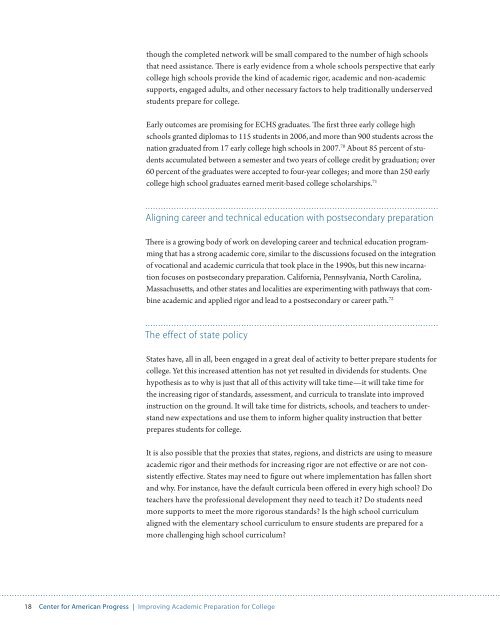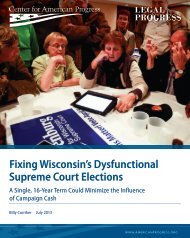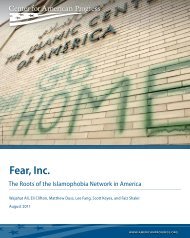Improving Academic Preparation for College - Center for American ...
Improving Academic Preparation for College - Center for American ...
Improving Academic Preparation for College - Center for American ...
You also want an ePaper? Increase the reach of your titles
YUMPU automatically turns print PDFs into web optimized ePapers that Google loves.
though the completed network will be small compared to the number of high schools<br />
that need assistance. There is early evidence from a whole schools perspective that early<br />
college high schools provide the kind of academic rigor, academic and non-academic<br />
supports, engaged adults, and other necessary factors to help traditionally underserved<br />
students prepare <strong>for</strong> college.<br />
Early outcomes are promising <strong>for</strong> ECHS graduates. The first three early college high<br />
schools granted diplomas to 115 students in 2006, and more than 900 students across the<br />
nation graduated from 17 early college high schools in 2007. 70 About 85 percent of students<br />
accumulated between a semester and two years of college credit by graduation; over<br />
60 percent of the graduates were accepted to four-year colleges; and more than 250 early<br />
college high school graduates earned merit-based college scholarships. 71<br />
Aligning career and technical education with postsecondary preparation<br />
There is a growing body of work on developing career and technical education programming<br />
that has a strong academic core, similar to the discussions focused on the integration<br />
of vocational and academic curricula that took place in the 1990s, but this new incarnation<br />
focuses on postsecondary preparation. Cali<strong>for</strong>nia, Pennsylvania, North Carolina,<br />
Massachusetts, and other states and localities are experimenting with pathways that combine<br />
academic and applied rigor and lead to a postsecondary or career path. 72<br />
The effect of state policy<br />
States have, all in all, been engaged in a great deal of activity to better prepare students <strong>for</strong><br />
college. Yet this increased attention has not yet resulted in dividends <strong>for</strong> students. One<br />
hypothesis as to why is just that all of this activity will take time—it will take time <strong>for</strong><br />
the increasing rigor of standards, assessment, and curricula to translate into improved<br />
instruction on the ground. It will take time <strong>for</strong> districts, schools, and teachers to understand<br />
new expectations and use them to in<strong>for</strong>m higher quality instruction that better<br />
prepares students <strong>for</strong> college.<br />
It is also possible that the proxies that states, regions, and districts are using to measure<br />
academic rigor and their methods <strong>for</strong> increasing rigor are not effective or are not consistently<br />
effective. States may need to figure out where implementation has fallen short<br />
and why. For instance, have the default curricula been offered in every high school? Do<br />
teachers have the professional development they need to teach it? Do students need<br />
more supports to meet the more rigorous standards? Is the high school curriculum<br />
aligned with the elementary school curriculum to ensure students are prepared <strong>for</strong> a<br />
more challenging high school curriculum?<br />
18 <strong>Center</strong> <strong>for</strong> american progress | improving academic preparation <strong>for</strong> <strong>College</strong>









